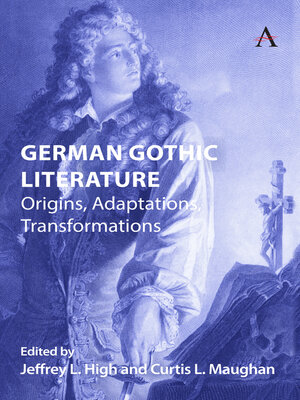German Gothic Literature
ebook ∣ Origins, Adaptations, Transformations · Anthem Studies in Gothic Literature
By Curtis Maughan

Sign up to save your library
With an OverDrive account, you can save your favorite libraries for at-a-glance information about availability. Find out more about OverDrive accounts.
Find this title in Libby, the library reading app by OverDrive.



Search for a digital library with this title
Title found at these libraries:
| Library Name | Distance |
|---|---|
| Loading... |
The volume is organized chronologically in three parts that pursue a broader organizational trajectory, articulate the common genre characteristics, destabilize boundaries and emphasize socio-artistic ruptures, while establishing the place of German cultural output within the framework of the Anglo-German gothic phenomenon. Furthermore, the volume distinguishes itself through a focus on the evolution from these early texts through the adaptations and original contributions by authors of early nineteenth-century romantic narratives of the unexplained in prose and verse, emphasizing the evolution of forms both within and beyond the oeuvres of individual authors, generations and movements. The second wave of German Gothic features the rise of the fairy tale, folklore, collections of ghost stories, entertainment literature, philosophical treatises and literary journals through the neo-romantic works of the turn of the twentieth century. The volume concludes with reevaluations of the German canon and explorations of global responses, expanding the research focus to encompass the transmedial productions of the twentieth and early twenty-first centuries, including popular novellas, horror cinema, prestige television and indie and mainstream video games.
|The story of German gothic literature is that of the meteoric rise of a popular literary style that critics nonetheless considered an unwelcome intruder, often dismissing it as the pulpy mimicry of British forerunners and as a "plague ship of German letters" (Charles Maturin), from its beginnings with the German art ballad or Kunst ballade of Herder, Goethe, Bürger, and Hölty in the 1770s and 1780s to the gothic prose works of Schiller, Goethe and Kleist, et al. In particular, the German novella was the object of some suspicion, and, as Schiller complained of his gothic bestseller Der Geisterseher in 1788, the prose author was considered the unloved, "half-brother of the poet." Kleist was ashamed to be associated with the disreputable genre, deriding the tendency of late-eighteenth-century literature toward stories about "knights with ghosts." Focusing on its gothic character, no less an authority than Coleridge dismissed German Sturm und Drang and Romantic literature as merely derivative of the gloomy works of Young, Hervey, Richardson and Walpole. In her novel Northanger Abbey (1818), Austen characterizes the 1790s as a decade of "horrid" novels so stereotypically gothic and German that its most popular works constitute self-parodies on both counts. Despite the English roots of gothic literature touched on above and its increased prominence in England from 1790–1820, by the 1820s, gothic tales were so clearly established as "German Stories"—thus the title of a three-volume British collection of 1826—that Poe felt the need to reclaim the genre for all humanity in 1839: "I maintain that terror is not of Germany, but of the soul [...]." The rest is literary history: gothic literature, and in particular German gothic short prose literature, has proven to be among the most resonant hypotexts, adapted and re-adapted in Anglo-American and European literature and film to the present day. This volume seeks to reevaluate German gothic literature after the wave of publications on the subject that renewed scholarly interest in these texts in the first decades of the twenty-first century.







